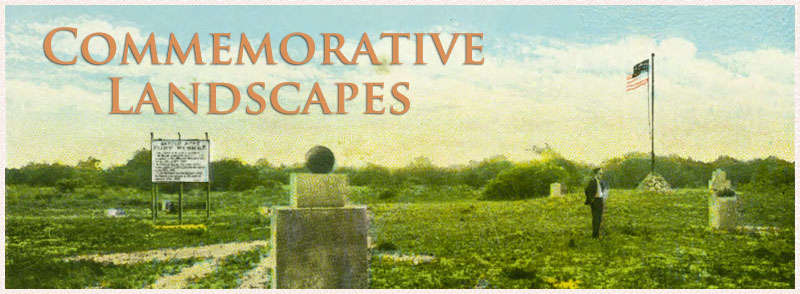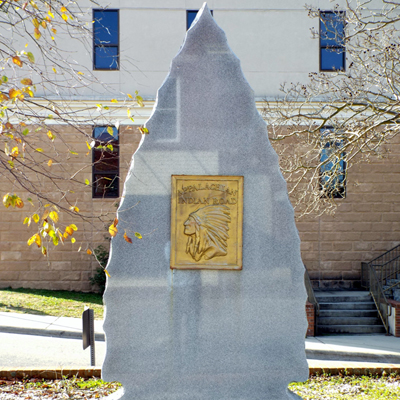
Appalachian Indian Road (Boone Trail Highway Marker #59), Lumberton
This Boone Trail Highway marker consists of a steel tablet with the portrait of an Indian Chief attached to a 7-feet tall granite arrowhead. The bas-relief portrait was intended to represent “Chief Sequoia” (Sequoyah) of the Cherokee but shows an Indian wearing a feather headdress more indicative of plains Indians than the Cherokee. Although sponsored by the Boone Trial Highway and Memorial Association a Daniel Boone tablet is not present on this marker which was placed to mark old Indian trading paths and buffalo trails. The arrowhead is cut from a single piece of granite and was placed after 2006 behind the Robeson County Courthouse. The original marker, dedicated in 1933, was of stone and masonry construction. It was destroyed in 2006 by a runaway car. The original memorial also had a Buffalo Trail tablet (see subject notes) and a glass enclosed legend showing the route of the trail and listing supporting organizations and individuals. The Chief Sequoia tablet on this monument includes an inscription for the Appalachian Indian Road unlike the one placed about the same time in the nearby Robeson County town of Pembroke.
This Boone Highway marker was numbered 59 by Everett G. Marshall. His interest and research of the markers led to the book, Rich Man, Daniel Boone. The numbering system was simply the order in which he found or became aware of a marker.
Images:
Far-off view of the memorial
APPALACHIAN INDIAN ROAD
Robeson County
April 23, 1933
34.620010 , -79.007930
View in Geobrowse
“The Boone Tablet,” Winston Salem Journal (Winston-Salem, NC), May 17, 1916
"J. Hampton Rich," from the "Images of North Carolina" digital collection, Davie County Public Library, (accessed January 21, 2015) Link
"Robeson County Court House, Lumberton, N.C." Durwood Barbour Collection of North Carolina Postcards (P077), North Carolina Collection Photographic Archives, Wilson Library, UNC-Chapel Hill Link
Jones, H.G. “Rich, Joseph Hampton,” NCPedia.org, (accessed March 22, 1917) Link
Jones, Randell. “Markers for Boone’s Trail Have Rich History,” Journal West (Winston-Salem, NC) November 26, 2013, (accessed March 13, 2017) Link
Marshall, Everett G. Rich Man: Daniel Boone (Dugspur, VA: Sugar Tree Enterprises, 2003)
Stanford, Raney. “Shades of Dan’l Boone! Says J.H. Rich,” The Daily Tarheel (Chapel Hill, NC), February 8, 1948
University of North Carolina at Pembroke. “Landmarks and Points of Interest” at http://www.uncp.edu, (accessed February 14, 2016) Link
“Boone Trail Marker #59-Lumberton NC," Waymarking.com, (accessed February 13, 2016) Link
“Giant Arrowhead Is Unveiled Here Before Big Crowd,” The Robesonian (Lumberton, NC), April 24, 1933, 1
“To Unveil Three Boone Trail Arrowheads Here,” The Robesonian (Lumberton, NC), April 10, 1933, 3
Yes
Original: local stone and concrete, steel plaque. Replica: marble, bronze
Joseph Hampton Rich
Mr. E.M. Stacy made the principal address at the dedication and quoted from President Roosevelt’s inaugural address, who pledged to be “guided by the sentiment which characterized the spirit of the American pioneer.” Stacy then called attention to the memory of both “whites and Indians of the pioneer days, and to the struggle between them…without analyzing the rights and wrongs…as the result has been American civilization.” After the primary speech J. Hampton Rich presented the monument which was unveiled by three sisters, Rebecca, Dorothy and Catherine Boone, descendants of Daniel Boone.
J. Hampton Rich was a well-known figure in North Carolina’s “Good Roads Movement” during the early 20th Century when public pressure was used to force enhancements in the public highway system. Attaining minor celebrity status he eventually extended his vision beyond the borders of his home state. Using the legacy of Daniel Boone as a hook, he first began to cross North Carolina and then the United States drumming up support for commemorative highway markers. Between 1917 and 1938 Rich was one of the most prolific commemorators in the United States. He claimed responsibility for hundreds of markers, some in places that had no connection to Boone at all like Washington, D.C.; Boston, Massachusetts; Pike’s Peak, Colorado and at the Golden Gate Bridge in San Francisco.
Rich was born in 1874 on land where the family of Daniel Boone may have once lived. What is certain though is that Daniel Boone spent many of his 21 years in North Carolina living in the area near Mocksville in Davie County and surely Rich's lifelong passion for Boone was influenced by his immersion in local lore surrounding the famous frontiersman. Rich, who became a well-known newspaper man in Winston-Salem, also developed a passion for good highways in the state. Very likely taking a lead from a series of markers to Boone placed by the Daughters of the American Revolution beginning in 1912, Rich combined his two passions and came to the idea of capitalizing on the pioneer’s fame as a way to encourage the building of better roads.
In 1913, Rich established the Boone Trail Highway and Memorial Association with the chief purpose to raise awareness of the need for better roads in North Carolina. Rich also wanted to educate the public about the history and heritage of the pioneer era and promote patriotism. Beginning with the first documented marker, placed at East Bend in Yadkin County in 1917,
Rich claimed to have placed about 360 tablets across the United States by 1938. Of that number, (which came from Rich) less than 60 originals are still known to exist and it may be impossible to ever know how many were actually incorporated into a highway memorial. Although it is known that he sold some in the early years Riches method of operation was typically to give a tablet, sometimes multiple tablets, to a community with their promise to raise funds to erect the highway marker. In some cases it was years before a marker was ever constructed and it is almost certain that many markers were never completed. The number of markers with documented proof of being completed is less than 150. As more digitally preserved newspapers from the period become available this number will likely increase.
Each tablet with the image of Daniel Boone includes wording that it contains metal from the Battleship USS Maine sunk in Havana harbor in 1898 at the outset of the Spanish-American War. In 1916 with the help of then Secretary of the Navy, Josephus Daniels, Rich had acquired 300 pounds of metal salvaged from the ship. It is questionable that each plaque actually contained some of this metal. In a 1948 article from “The Daily Tar Heel” Rich is quoted as saying “the first tablets contained... metal from the battleship.” In addition to those featuring Daniel Boone, Rich also created tablets featuring “Cherokee Chief Sequoia” and a bison in an effort to mark ancient buffalo traces used by Native American and then Colonial settlers from the coast at Wilmington through the Great Smoky Mountains in the west. Very few of these were produced and few examples remain. Other efforts include tablets to Abraham Lincoln and possibly Davey Crockett. Regardless of the image on the tablet, these are lumped together under the heading of Boone Trail Highway and Memorial Association markers. The best current resource is Rich Man: Daniel Boone by Gary Marshall. His research efforts and the book’s publication in 2003 generated interest in finding and protecting the remaining markers.
Rich lived in Chapel Hill in the years prior to his death in 1949 where he could be seen “striding down the village streets wearing his coon skin cap and maybe with his long rifle thrown over one arm.” He was also "apt any day to walk into one of the University’s history classes clad in his furry cap, and always on these occasions he is introduced to the students by the professors as Daniel Boone."
The arrowhead stands behind the Robeson County Courthouse that is located at 500 N. Elm Street, Lumberton.
Also behind the courthouse to the right of this marker, at the corner of N. Court
Square Street and N. Chestnut Street, is a paved courtyard
with the Robeson County War Memorial and plaques to General John Willis, George Washington Tree, Colonel Thomas Robeson, and George G. McPhail, Jr.
In front of the Courthouse is the Confederate Monument.
A 1939 bronze plaque to Robeson County War Dead is located inside the courthouse. It replaced a wooden painted tablet placed in March 1919.
The memorial stands on a raised brick garden bed, under shady trees.
The arrowhead was originally located on the grounds of the old Lumberton High School at Walnut Street and Elizabethtown Road.
 Know anything else about this monument that isn't mentioned here? If you have additional information on
this or any other monument in our collection fill out the form at the Contact Us link in the footer. Thank you.
Know anything else about this monument that isn't mentioned here? If you have additional information on
this or any other monument in our collection fill out the form at the Contact Us link in the footer. Thank you.

